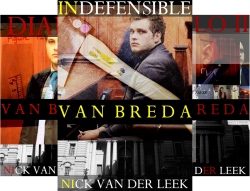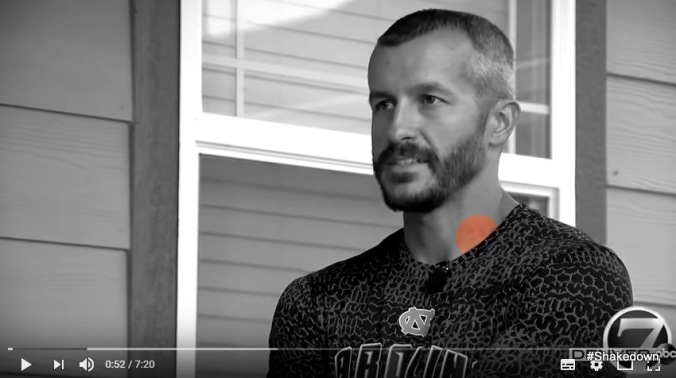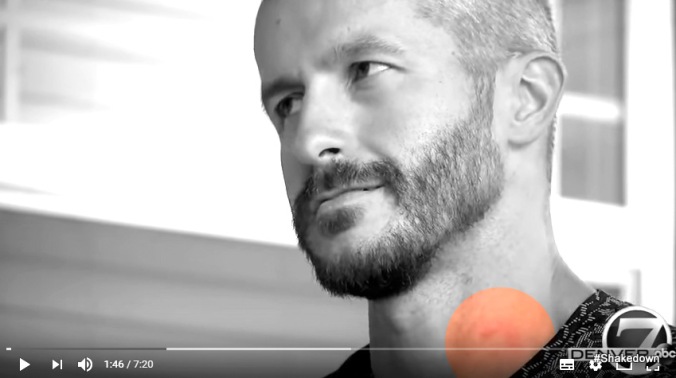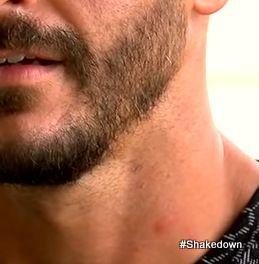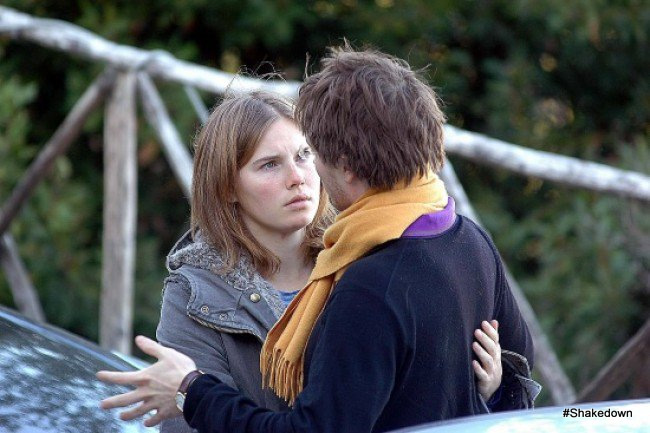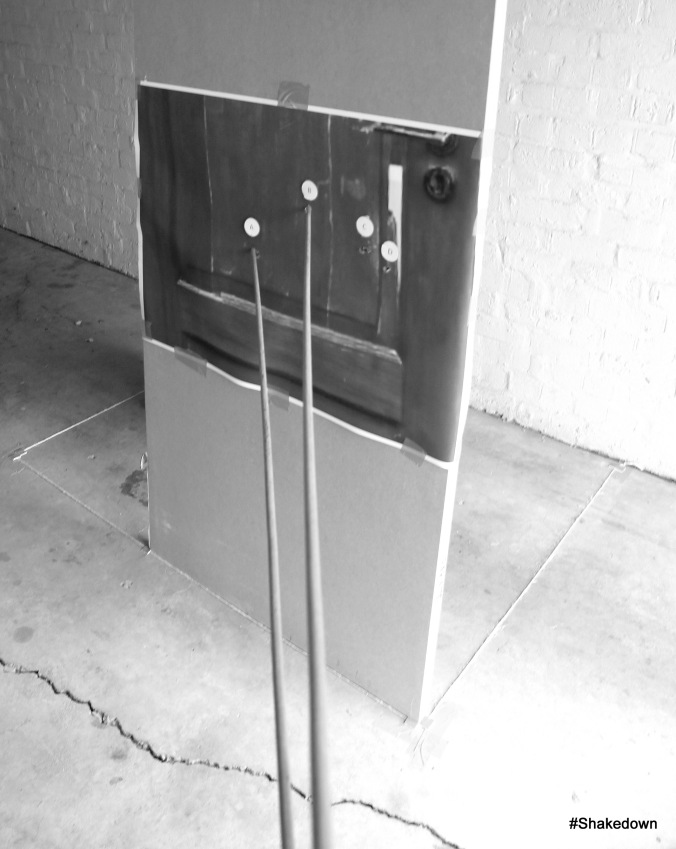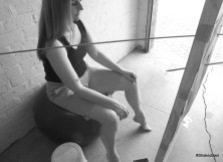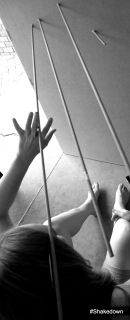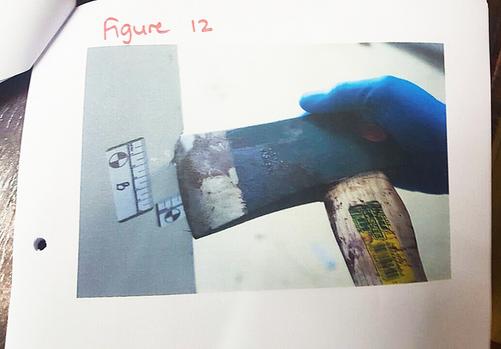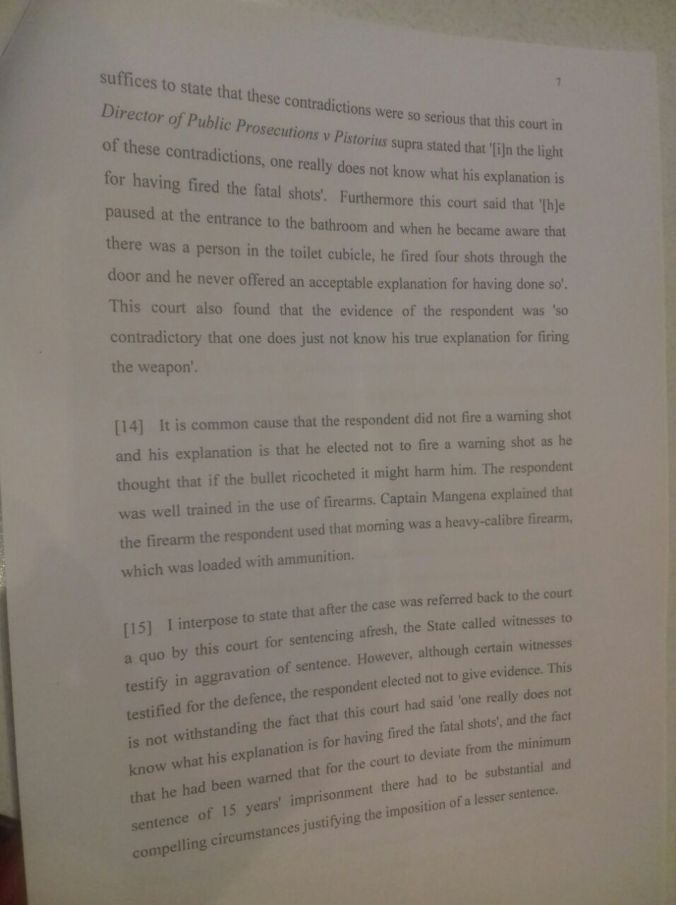What goes on behind closed doors? What happens underneath appearances, edifices and facades? Knock, the Bible says, and the door will be opened. So let’s knock on the brown door at 2825 Saratoga Trail.

Today we’re going to deal with one of your questions on #Shakedown. It’s this idea that there’s “no why”.

There is a why, and it’s behind that door. Just because the door’s not opening, doesn’t mean nobody [and no why] is home. Is there a way we can get inside, without the door being opened? Actually, there is. But before we open that door, let’s look at part of Diana’s question:
“…when a pregnant woman is murdered or mysteriously just disappears, it’s almost always the father of the unborn child who’s responsible for her death/disappearance….”
This casual remark is startlingly close to the essence of what we need to get at, and why we can’t see what we need to see, why we can’t get in the door. The reason the door is staying closed isn’t because the door won’t upon, but because we’re not open. We must open our minds.
Taking Diana’s statement, the reason we’re defeated at the door is because we see this case through the prism of our own minds.
…it’s almost always the father of the unborn child who’s responsible…
If we want to see into Chris Watts’ mind, then we have to let go of what we know, of our standards for ourselves, our realities, and be open to someone else’s. In this case what that means is:
…it’s almost always the father of the unborn child who DOES NOT WISH TO BE responsible…
And then, in the aftermath of the crime, we see that habitual flouting of responsibility writ large. He won’t admit what he’s done because he can’t, because he’s been living a lie. For us, reality has caught up with him, but when you’re living a lie, reality never catches up, and liars – especially murderers – make sure it never does. That’s why they commit murders, to escape their reality.
All of this is very loosey-goosey though. What are we really dealing with though? Practically? We enter the door of Chris Watts mind by using a key I call True Crime Intertextuality. It’s a tool we use to begin profiling our killer’s psychology. We use it to decipher not only who he is, but who he isn’t.
Let’s use Diana’s first example. Christopher Coleman. How like Chris Watts is Coleman, and how like the Watts crime, is Coleman’s crime?
The Coleman Case
An attorney for Christopher Coleman, who was convicted of strangling his wife and two children in May 2009, is requesting a new trial.
Coleman was found guilty in 2011 of strangling his wife, Sheri, 31, and their sons, Garett, 11, and Gavin, 9, in their home in Columbia, Ill. He was sentenced by a judge to three life terms without possibility of parole.
But this week — almost seven years after that conviction — Coleman’s appointed attorney Lloyd Cueto Jr. filed a petition arguing that the jury’s verdict hinged on four explicit photos that were not properly reviewed by the court.
The photos were exchanged between Coleman and his then-mistress, Tara Lintz.
During the trial, prosecutors alleged that Coleman wanted to leave his wife to marry Lintz. Exposing his adultery, the prosecution said, would have jeopardized Coleman’s $100,000-a-year job as bodyguard for televangelist Joyce Meyer.
Prosecutors argued that lurid emails, texts, photos and videos between Coleman and his lover showed Coleman’s motive to kill his family and indicated the emotional intensity of the affair.
Defense attorneys asked that the images be banned because they could prejudice the jury against Coleman due to their explicit content.
Judge Milton Warton opted to allow some of the images but specified that the genitals in the photos be covered with black bars.
But during deliberation, thumbnail versions of the images that were not censored were let into the jury room on the back of a foam evidence board, according to Cueto’s petition.
The thumbnails included time stamps that were not entered into evidence, Cueto said.
Multiple jurors later told reporters from the TV show “48 Hours” and the Post-Dispatch that reading the time stamps with a magnifying glass was a turning point for some of the jurors in the 15-hour deliberation.
The dates on the photographs indicated they had been taken as early as October 2008, in contradiction of testimony by Lintz that the affair began two months later.
Ferrari told the Post-Dispatch the jury also came to believe the time stamps showed Coleman was deleting photos while police were interviewing him on the day of the murders.
Ferrari said several jurors were initially unwilling to find Coleman guilty, but the vote shifted after the discovery of the time stamps.
Coleman’s attorney argues the jurors should have never been able to see those dates and times.
“The jurors made their decision based on something that was never admitted into evidence,” Cueto said.
Cueto’s petition also points to the omission of other evidence during the trial including fingerprints and a shoe print that may have cast doubt on the prosecution’s narrative of events during the trial.
Monroe County State’s Attorney Chris Hitzemann must now review the petition and decide how to proceed, Cueto said.
Hitzemann was not in office during the trial that captivated the local community in 2011 with its combination of sex, religion and violence.
The region was so transfixed by the courtroom drama that the Monroe County Circuit Clerk told the Post-Dispatch at the time that there was a waiting list of 165 area residents hoping to sit in on the trial. The eventual jurors were bused in from Perry County.
Clearly a single news story about a murder is nowhere near sufficient if we’re looking to produce a psychological blueprint for our suspect. But we’re not trying to do that just yet, not exhaustively anyway. All we want to do right now is get a handle on the basic criminality.
A quick gloss through the red highlighted text below confirms that in many [but not all] respects, the Coleman case is a reasonably good fit for the Watts case. We can tick the following boxes:
- The manner [or mechanism] of death, for both Sheri and her two sons Gavin and Garett was the same – death by strangling. Follow this link to see the difference between cause of death and manner of death.
- The murders took place inside the residence.
- There was a secret mistress involved.
- The secrecy was important to maintain – Coleman stood to lose his job if he didn’t keep it secret.
- The adultery was well-established. It wasn’t merely a fling, it was a serious relationship.
- Coleman wished to establish a new life with a new wife but for known and unknown reasons, felt he could not do that in a conventional manner. The known reason is that he stood to lose his job. The unknown reason has something to do with religion.
- Coleman’s employment [as a bodyguard to an evangelist] was an important feature in the case.
- The motive according to prosecutor’s was the emotional intensity of the affair. Whether this is accurate or not, we see that emotional intensity on top of other key factors can trigger family murders.
- The lifespan and seriousness of the affair was undermined and underreported by the mistress, which is indicative that not only was Coleman reluctant to acknowledge what he’d done, but the mistress as well.
- Coleman was actively removing evidence while he was being investigated. Much of this involved destroying digital artifacts, especially photos.
- Jurors were initially unable or unwilling to find Coleman guilty.
- The court case ultimately turned on a factor that wasn’t even part of the court evidence [which had to do with the timeline of events, and also Coleman and his mistress lying about that particular aspect].
In sum the Coleman case involved a toxic combination of sex, religion and violence. We may say the odd element in this mixture – in terms of the Watts case – is religion. But before throwing the baby out with the bathwater, wasn’t Thrive the “religious” element in the Watts case? In Two Face I compared the activities of Le-Vel employees to those of a cult. With most cults it’s difficult to leave, and the costs associated with leaving – and staying – are enormous.
Another aspect that’s similar is the age and to some extent, the appearance of the victim. Sheri was an attractive blonde mother, 31 years of age. Shan’ann was 34, brunette and also attractive. Appearances – vanity – with regards to sexual attractiveness and the perceived sexual attractiveness of the murderer spouse, often figure highly in family murders.
The key element in the Watts case missing from the Coleman case is that Sheri wasn’t pregnant. Now let’s examine a case where the victim was pregnant.
The Hacking Case
The reference case below is longer and divided in two parts. It’s not necessary to read the entire script, simply gloss through the highlighted text.

7/19/04 Salt Lake City, Memory Grove Mark Hacking talks to the media on the first day his wife Lori is reported missing. He has now been arrested on charges of aggravated murder.
Brian Hamilton became friends with Mark Hacking when they worked together in the children’s psychiatric unit of a Salt Lake City hospital. He said Hacking loved to entertain the kids at the hospital.
The couple had just learned Lori was five weeks pregnant, friends say. And they were about to embark on a cross-country move to North Carolina, where Hacking said he would be starting medical school. “It seemed as though they had their life planned, chapter by chapter,” says Hamilton.
On Thursday, July 15, Lori emailed the Hamiltons with their new address. But the day after she sent the email, Lori received a phone call from the University of North Carolina. She left work early in tears. Apparently, she’d just learned that Mark’s big plans for medical school were all a lie. He’d never even enrolled with the school.
A few days later, on Sunday evening, the couple went to a convenience store. It’s the last place where anyone would see Lori Hacking alive. As seen in surveillance footage from later that night, Hacking returned to the store around 1 a.m. – but this time, he was alone.
Now that Hacking has allegedly confessed to killing his wife while she was sleeping, people wonder, after seeing these images on the surveillance tape, had he just murdered his wife? Or was he about to?
The next morning, Hacking reported his wife missing. He said she never came home after going for an early jog in nearby woods. Hacking said he went searching for her, but later that day, police learned that he’d been shopping for a new mattress before he called 911. That was the first sign that Hacking’s concern for his wife was all an act. And it was the first of many lies to come.
“My name is Mark Hacking,” he said in a press conference. “And I have so much gratitude today for the friends, the family, the officers, the search-and-rescue people. Everybody. It’s just been the worst day of my life; it’s good to feel some comfort from the community.”
Later that night, Hacking was admitted to a psychiatric hospital after he was seen walking around outside, naked. “He kept his shoes on – his sandals – that’s not generally something we see in someone truly psychotic,” says Candace DeLong, who was an FBI profiler for 20 years.
Does she think he was faking his condition and setting up a defense? “I think there’s a very good chance he thought that might work,” says DeLong. In the days following Lori’s disappearance, while hundreds of volunteers searched for her, it became apparent that Hacking had been making up stories for years.
“We were under the impression that Mark had been accepted to medical school and just found out a few minutes ago he never even applied to medical school at North Carolina,” says Mark’s father, Douglas Hacking.
In fact, Hacking had never even graduated from college. He stopped attending classes at the University of Utah three years ago, and Lori, and Mark’s family, found out.It’s a story that’s never been reported in detail.
“His mother called their house and left a message asking why he wasn’t enrolled in school, ’cause she had attempted to pay the tuition and it wasn’t– he wasn’t in the — enrolled,” recalls Hamilton. Lori heard the voice mail first, and when Hacking came home, she confronted him. He took off in his car, and when Lori couldn’t find him, she called the Hamiltons. “She was just crying on the phone,” says Hamilton. Lori later found out Hacking was at a hotel an hour away.
“We didn’t really think anything of it because the next day, Jennifer talked to Lori and she said, ‘Oh, yeah. Well, we went and we reconciled things and made up,” says Hamilton. “And the way that it kind of played out was that he had made a mistake or he had forgotten to register. I think that’s how it went. We thought he went back to school.”
And apparently, so did Lori. And from then on, Hacking’s lies just got bigger and more elaborate. “I remember for the last two-plus years, the extensive preparations for medical school,” says Lori’s brother, Paul Soares. In fact, Mark went so far as to fly to Manhattan, and pretend to interview for medical school, while staying with his cousin. “He got up in the morning, put his suit on — like day before, she drove him by where Columbia was, so he’d know where it’s at,” recalls Soares. “And– left– went to do his interview and came back a few hours later and talked about the interview and how it was.”
“He talked a little bit about his deception to us, how it all got started a few years ago,” says Mark’s father, Douglas Hacking. “He has two brothers who are high achievers. He felt pressure to excel as well.”
The real tragedy is that many believe Lori would have loved Hacking, no matter what he did for a living.
“As long as he was doing his best, she would have loved him with all of her heart,” says Soares. “And he didn’t have to be a doctor, a president — whatever it was. As long as he was doing his best, she would have loved him.”
And Hacking may have been the only person who didn’t truly believe this.
“Failure just was not an option. It almost seemed like– he couldn’t handle the idea of letting her down,” says Hamilton. “Basically, I think that maybe he was just so sad or so distraught about the idea of letting her down that maybe something did snap. I mean what that was, I don’t know.”
There’s a lot there, but it’s not the half of it. We’re looking for more insight into Hacking’s psychology, and we find plenty more of that here:
According to Mark’s friend Paul [no surname given], Mark Hacking’s double life began when he was not accepted into a bachelor’s degree program at the University of Utah. Rather than tell his father that he had been rejected, he pretended that he had been accepted.
The desire to please his father, Paul said, was driven by a sense of inadequacy. Mark Hacking’s father is a successful pediatrician. A brother is also a doctor and another brother is an engineer.
Paul said Mark Hacking’s father – who he claimed to have known well for years – was not overbearing or demanding, and did not create the pressure Mark supposedly felt. Paul described Mark Hacking’s father as a wonderful man.
At any rate, when classes began at the university, Paul said that Mark Hacking bought the requisite textbooks and studied them, while telling his wife, parents and friends that he was a student. Paul claimed that he and Mark Hacking were routinely together during the time Mark was supposed to be in class. This happened semester after semester.
According to Paul, the entire charade was meant to keep Mark Hacking’s father from learning about his son’s academic difficulties. When asked why Mark Hacking lied to his wife, Paul said of Lori Hacking, “His wife is … the stereotypical ‘good Mormon girl,’ and she would have told his dad.”
The description sounded contemptuous as Paul said it. He also said that Lori Hacking would have been angry that her husband had lied to her. Which was apparently the case on the last weekend of her life. On Friday, at work, she accidentally learned from officials at the medical school her husband claimed to have been accepted to that he was not a student. The couple had made plans to move across the country the next week so that he could go to school.
Co-workers describe Lori Hacking as being very upset. And Paul says that when he went to the Hacking apartment on Sunday night Mark Hacking told him that he and Lori had argued angrily earlier in the evening. He also said the Hackings had argued other times in their marriage as well.
“She is a little spitfire,” Paul said of Lori Hacking. The description, again, sounded contemptuous as Paul said it.
He described Mark Hacking as extremely agitated that night. Paul said that he seemed frantic and at his wits end. The upset, though, was primarily from the fact he feared his wife would tell his father about his fraud, rather than that she had said she wanted a divorce.
Another previously unreported aspect of this story, if Paul’s account is correct, is that Mark Hacking – after claiming to have graduated from college – worked as a psychological counselor, something which he was apparently unlicensed and unqualified to do. Paul said that he and Mark Hacking had discussed Mark’s fears that he would be caught for that and sentenced to “five years in prison.”
Paul said that he counseled Mark Hacking to “disappear” for a couple of years, to escape his lies. Paul said that when he returned his father would be so glad to see him that he would forget about the deceptions. Additionally, the institution where Mark Hacking had supposedly performed the illicit counseling would sweep the matter under the rug, to avoid the embarrassment of having employed an unqualified person.
Paul also said that family statements that Lori Hacking was pregnant at the time of her murder are true. He said that Mark and Lori were ecstatic when she became pregnant. “He did not do this because she was pregnant,” Paul said of the murder.
Paul also said that Mark Hacking did not use drugs or alcohol, but that, rather, “He fits the stereotypical sociopath.”
Paul said that when he first heard media reports that Lori Hacking was missing he presumed that she had left Mark. Later that day, however, when he saw Mark Hacking on TV, claiming that his wife was missing, he said he knew Mark Hacking was lying and he turned and told his wife so at the time.
Concerned, Paul went to the volunteer search headquarters and told a police officer that he knew Mark Hacking and believed that he was lying. The officer took Paul’s name but did not seem interested. Paul was eventually interviewed by police a week later.
Paul also said that, contrary to rumors, he did not believe Mark Hacking was involved with pornography. And while Mark Hacking told Paul that he believed in his family’s Mormon faith, he felt that he couldn’t live it, but would later on, repenting of his wrongdoing.
Paul said that Mark’s plan was to move to North Carolina and pretend to go to medical school. He intended to keep up that charade and eventually “graduate” and go practice medicine with fraudulent credentials.

There more than twice as many boxes to tick here, than in the Coleman case. We won’t tick all of them, but let’s pluck the low hanging fruit and then see how the Hacking case stacks up to the Coleman case, and why Watts is more like one than the other.
- It’s one thing to talk about someone “living a lie”, isn’t another to actually see how it might play out in their lives. It’s impossible to feel the drama, desperation, intrigue and emotional intensity in the idea of someone else living a lie. But when we see the extent of it, and the absurdity of it, and the scale of how it plays out, we see just how destructive and consuming something as simple as a lie is. In Hacking’s case, the lie was that he was [or could be] successful. In the Watts case it’s the same. Of all the analysis posted on the Chris Watts case on Shakedown, this one is one of the most important, and the most overlooked. We see where he came from, not only humble beginnings but dirt poor. He wanted to keep his house, keep his idea of success, and Shan’ann was destroying it.
- Inadequacy. In the same way that some people are inadequate about their weight, or being bald, or being poor, or being unsuccessful, it doesn’t tend to mean very much unless it’s you. Unless the inadequacy is yours. Often we laugh at the inadequacies of others, but do we laugh at our own, or tried to hide them? The more inadequate people are the more they lie. The more lies the more the tendency to live a lie. And the murder is just a natural end to that process, which is why after the murder, it’s so easy to lie about what happened as well.
- Our identities – who we are – are built on what we do for a living. Chris Watts either felt a sense of crisis about what he was doing, or what Shan’ann was doing, but probably both. It’s not a one-way dynamic, it’s a two way dynamic.
- Curiously in the Hacking case, the murders have nothing to do with a mistress, though one could argue that the secret medical school fraud was his mistress. It’s the thing he felt guilty, insignificant and inadequate about.
- We see a mirror in the confining Mormon faith on the one hand, which artificially forces the marriage to remain in place, and the contempt Mark apparently feels for his demanding Mormon wife. An analogy for this in the Watts case are the artificial forces of the Thrive cult, and the impact of strictures and expectations that had on him. In the Hacking case, the Coleman case and the Watts case, there’s a an overarching belief system that causes the men to feel trapped into their own lives.
- Hacking didn’t murder his wife because she was pregnant, but the pregnancy undoubtedly had an impact of the dynamic, heightening expectations, stakes and the levels of alertness and aggravation for all involved.
- In the Hacking case we see a clear precedent for a scenario of lies which he got away with [the psychological counselling] and this then sets the tone for a much bigger set of lies. It’s unclear what set the precedent for Chris – whether it was the MLM, or his own sexuality, or the affair, or some subset of deceits we don’t know about yet.
- In the Hacking case there’s also the initial suspicion that Lori had left her husband because of acknowledged marital strife. In the Watts case there’s no sign of marital strife in the narrative until Shan’ann’s dead. Then it’s invoked as something that happened on the morning of her death. Had they really never argued? Or was this pressure to pretend to never argue the real pressure cooker in the Watts family dynamic?
- Hacking apparently believed in his family’s Mormon faith, but couldn’t live it. Chris Watts probably found himself in the same dilemma. He believed in the idea of his marriage, but couldn’t live it. Why not? Refer back to point 1.
- Many of us look at the Watts case, especially the interview on the porch, and we can clearly see that his goose was already cooked then. But that’s not what we need to see to figure out this case, and the man underneath Christopher Watts. See – he couldn’t see it. There were so many lies he was still buried under them. In the same way, even though Hacking couldn’t hack medical school, he had every intention of pretending to enrol, pretending to take classes, pretending to graduate and pretending to be a doctor. He had no problem with that. The problem was, his wife did. She was exposing him for the very thing he was trying to hide – a fraud, a cheat, an imposter, a victim of his own inadequacy. When the lie is big enough, the desperation can be just as big to defend it.
That’s ten, that’s enough.
There should be some inklings, by now, what lie Chris Watts was trying to defend. It wasn’t a small lie, which is why he went to such extraordinary efforts to do what he did.
Between the Coleman case and the Hacking case we have plenty of blueprint material. One family murder involves a mistress, a mother and two children [but she’s not pregnant], while the other has no mistress and a pregnant mother, but no children. The one case involves the fear of losing a job and an income, the other involves a man who’s afraid to lose an idea of himself.
While Watts and the Watts case is similar in many respects to both Coleman and Hacking, it’s obvious that Chris Watts is much closer to Hacking’s psychology than Coleman’s, isn’t it? What this reveals is that unlike Coleman, Watts wasn’t stuck in a religious or quasi religious dimension, in fact, the crime probably happened because of it, to extricate himself out of it.

Like Hacking, Watts felt contempt for Shan’ann. The thing burning him, see, was that she was exposing his inadequacies – as a man, as a father, as a success, to the world [via Facebook, via the marriage, via the whole parenting debacle].
Despite her glowing endorsements on Facebook, Shan’ann had confided to a friend that “he has no game”. Well, he was determined to prove that he did.
Did he?
Has he, so far?


Two Face is available exclusively at Amazon.com





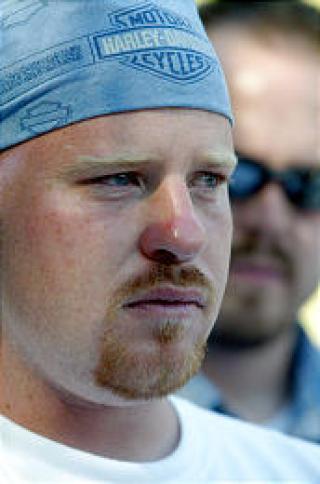




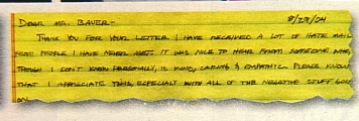





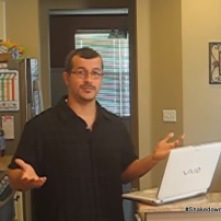







 Now, did friends visiting the family in the week before the murders know better, have better insight than the Uncle living in Pretoria? You’d think so, wouldn’t you? In this tiny little snippet are big answers, though incomplete answers, to the riddle of why. The first is so obvious it’s almost ridiculous. Henri was laboring under acute sibling rivalry. Whether you want to call it a sense of his brother being favored by his father, or Henri himself being jealous of Rudi, it’s the same thing. It’s sibling rivalry that’s at the center of a crime, and thus, it’s the key to seeing why Henri’s attack started where it did and with whom: Rudi in the boy’s room.
Now, did friends visiting the family in the week before the murders know better, have better insight than the Uncle living in Pretoria? You’d think so, wouldn’t you? In this tiny little snippet are big answers, though incomplete answers, to the riddle of why. The first is so obvious it’s almost ridiculous. Henri was laboring under acute sibling rivalry. Whether you want to call it a sense of his brother being favored by his father, or Henri himself being jealous of Rudi, it’s the same thing. It’s sibling rivalry that’s at the center of a crime, and thus, it’s the key to seeing why Henri’s attack started where it did and with whom: Rudi in the boy’s room.




